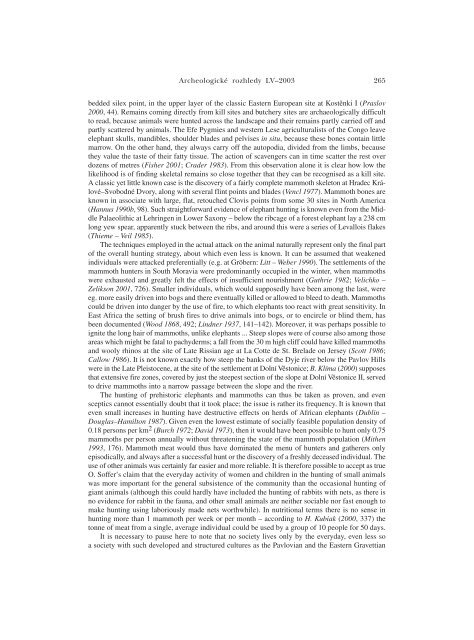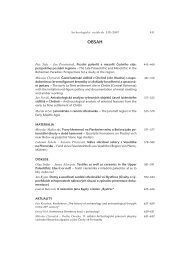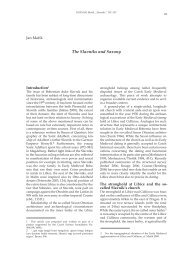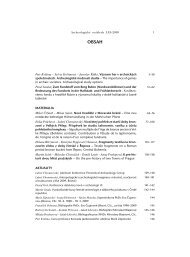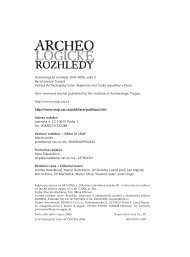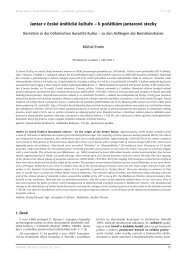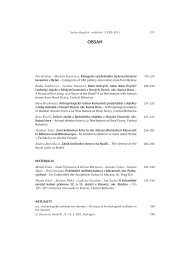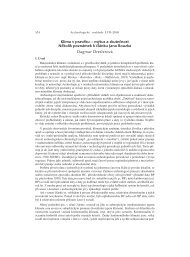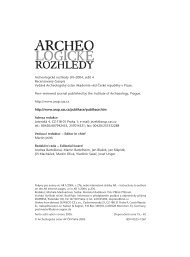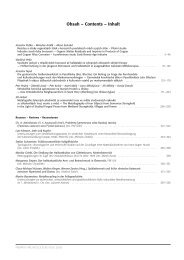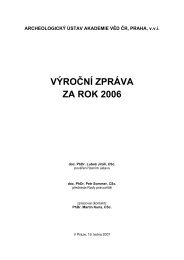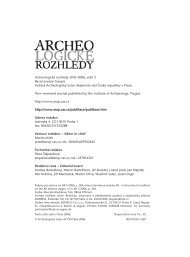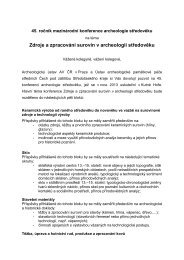2003_2 - Archeologický ústav AV ČR
2003_2 - Archeologický ústav AV ČR
2003_2 - Archeologický ústav AV ČR
Create successful ePaper yourself
Turn your PDF publications into a flip-book with our unique Google optimized e-Paper software.
Archeologické rozhledy LV–<strong>2003</strong> 265bedded silex point, in the upper layer of the classic Eastern European site at Kostěnki I (Praslov2000, 44). Remains coming directly from kill sites and butchery sites are archaeologically difficultto read, because animals were hunted across the landscape and their remains partly carried off andpartly scattered by animals. The Efe Pygmies and western Lese agriculturalists of the Congo leaveelephant skulls, mandibles, shoulder blades and pelvises in situ, because these bones contain littlemarrow. On the other hand, they always carry off the autopodia, divided from the limbs, becausethey value the taste of their fatty tissue. The action of scavengers can in time scatter the rest overdozens of metres (Fisher 2001; Crader 1983). From this observation alone it is clear how low thelikelihood is of finding skeletal remains so close together that they can be recognised as a kill site.A classic yet little known case is the discovery of a fairly complete mammoth skeleton at Hradec Králové–SvobodnéDvory, along with several flint points and blades (Vencl 1977). Mammoth bones areknown in associate with large, flat, retouched Clovis points from some 30 sites in North America(Hannus 1990b, 98). Such straightforward evidence of elephant hunting is known even from the MiddlePalaeolithic at Lehringen in Lower Saxony – below the ribcage of a forest elephant lay a 238 cmlong yew spear, apparently stuck between the ribs, and around this were a series of Levallois flakes(Thieme – Veil 1985).The techniques employed in the actual attack on the animal naturally represent only the final partof the overall hunting strategy, about which even less is known. It can be assumed that weakenedindividuals were attacked preferentially (e.g. at Gröbern: Litt – Weber 1990). The settlements of themammoth hunters in South Moravia were predominantly occupied in the winter, when mammothswere exhausted and greatly felt the effects of insufficient nourishment (Guthrie 1982; Velichko –Zelikson 2001, 726). Smaller individuals, which would supposedly have been among the last, wereeg. more easily driven into bogs and there eventually killed or allowed to bleed to death. Mammothscould be driven into danger by the use of fire, to which elephants too react with great sensitivity. InEast Africa the setting of brush fires to drive animals into bogs, or to encircle or blind them, hasbeen documented (Wood 1868, 492; Lindner 1937, 141–142). Moreover, it was perhaps possible toignite the long hair of mammoths, unlike elephants ... Steep slopes were of course also among thoseareas which might be fatal to pachyderms; a fall from the 30 m high cliff could have killed mammothsand wooly rhinos at the site of Late Rissian age at La Cotte de St. Brelade on Jersey (Scott 1986;Callow 1986). It is not known exactly how steep the banks of the Dyje river below the Pavlov Hillswere in the Late Pleistocene, at the site of the settlement at Dolní Věstonice; B. Klíma (2000) supposesthat extensive fire zones, covered by just the steepest section of the slope at Dolní Věstonice II, servedto drive mammoths into a narrow passage between the slope and the river.The hunting of prehistoric elephants and mammoths can thus be taken as proven, and evensceptics cannot essentially doubt that it took place; the issue is rather its frequency. It is known thateven small increases in hunting have destructive effects on herds of African elephants (Dublin –Douglas–Hamilton 1987). Given even the lowest estimate of socially feasible population density of0.18 persons per km 2 (Burch 1972; David 1973), then it would have been possible to hunt only 0.75mammoths per person annually without threatening the state of the mammoth population (Mithen1993, 176). Mammoth meat would thus have dominated the menu of hunters and gatherers onlyepisodically, and always after a successful hunt or the discovery of a freshly deceased individual. Theuse of other animals was certainly far easier and more reliable. It is therefore possible to accept as trueO. Soffer’s claim that the everyday activity of women and children in the hunting of small animalswas more important for the general subsistence of the community than the occasional hunting ofgiant animals (although this could hardly have included the hunting of rabbits with nets, as there isno evidence for rabbit in the fauna, and other small animals are neither sociable nor fast enough tomake hunting using laboriously made nets worthwhile). In nutritional terms there is no sense inhunting more than 1 mammoth per week or per month – according to H. Kubiak (2000, 337) thetonne of meat from a single, average individual could be used by a group of 10 people for 50 days.It is necessary to pause here to note that no society lives only by the everyday, even less soa society with such developed and structured cultures as the Pavlovian and the Eastern Gravettian


